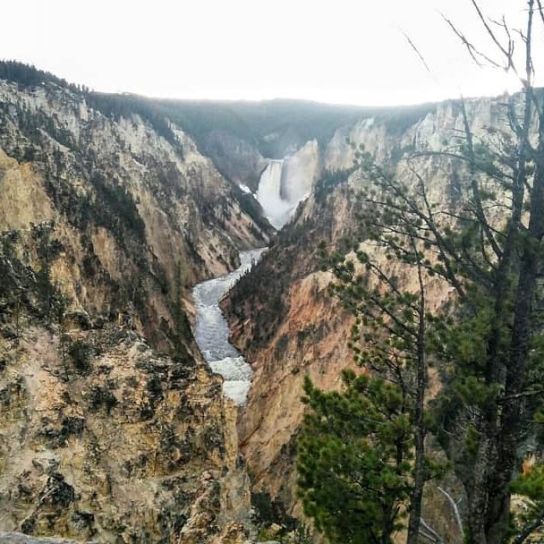After having explored mostly the concrete jungles of the United States, I wanted to explore the nation’s most treasured landscapes and could not think of anything better than Yellowstone National Park, America’s first National Park.
Spread across the states of Wyoming, Montana, and Idaho, with the majority chunk in Wyoming, Yellowstone is known for its geothermal areas and wildlife. On our way to the first geyser in Wyoming, we came across herds of bison grazing in the sun. Bison in Yellowstone constitute the US’ largest and oldest free-range herd. Natural disaster such as wildfire that has impacted sections of the park, parts of it rebounded with vegetation was evident.
The lost vegetation and the regrowth.
Bison Herd
Norris Geyser Basin
The wide-sweeping view in the picture is from a part of Norris Geyser Basin, named for its porcelain-like appearance, a result of centuries of thermal activity, hot water, mineral deposition, and the thriving microorganisms. Norris is lower in elevation. Iron deposition is one cause of rust colour in the basin you see in the second image. Most of Yellowstone thermal areas are alkaline, but Norris is acidic.
The ground in these areas may be just a thin crust above boiling hot springs. Visitors have to strictly walk the boardwalk or trail. Leaving the trail can result in severe burns and even death. Some pools are acidic enough to burn through boots. Violators if survived can be prosecuted.
Another feature that makes Yellowstone unique is the mud pots. Although not as picturesque as the rest of the springs, these turbulent pools of muddy water add character to the park.
Dragon’s Mouth Spring
Does the above picture look like lashing of a dragon’s tongue? Perhaps, that’s how this spring got its name. Frequently surging water from the cave, splashing as far as the boardwalk, rumbling sounds caused by steam and other gases exploding through the water makes the name more appropriate.
Grand Canyon of the Yellowstone
The first large canyon of Yellowstone is on the Yellowstone River, downstream from Yellowstone Falls. The geology is only known to be erosional rather than glaciation. The colour in the canyon is the result of hydrothermal reactions. Most of the yellow is the result of iron in the rock. That’s perhaps how the park got its name. We had to hike up a short distance to witness this view.

The Canyon

Yellowstone Falls
Mammoth Hot Spring Terraces
Heated water percolating through buried limestone and calcium carbonate deposits has changed the landscape to travertine terrace. Also, the underground channels sometimes clog or shift causing the water to change directions. Sometimes an active spring might become dormant and a dormant spring may flow again. Resulting in a beautiful landscape below which is named as Mammoth Hot Spring.
A closer look of the spring terrace
Liberty Cap – A dormant hot spring cone
Antelopes around the springs
Fountain Paint Pots
A half-mile Fountain Paint Pots trail takes you through dynamic hydrothermal areas in Yellowstone. This includes mud pots, geysers, hot springs exhibiting a variety of eruption patterns. Here again, it is mandatory to stay on the boardwalk.
Earthquake’s Offspring
Celestine Pool
Silex Spring
Spasm Geyser splashes to 3 feet.
The trail
Excelsior Geyser’s eruption ceased in 1890 and roared back to life in 1985 with 47 hours of significant eruptions. It is not predicted when this dormant but powerful geyser’s next eruption will be.
Excelsior Geyser
Yellowstone’s largest hot spring is Grand Prismatic Spring, stretching approximately 200 feet across. The colourful (Prismatic) spring looks like an artist’s mighty canvas.
Old Faithful
A highly predictable geyser was the first one in the park to get a name. The geyser erupts every 45 minutes to an approximate height of over 100 feet, which lasts for 15 to 20 minutes. The time of next eruption will be announced in the restaurants, hotels and other visitor’s centres. As suggested by our guide, we made sure to be at the viewing spot well in advance to witness the spectacle.
Prediction announcements
Next up we walked to Morning Glory Pool, 1.5 miles away from the Old Faithful. On our way, we came across numerous mud pots and geysers such as –
Grotto Geyser – one of the unusual geysers of Yellowstone which erupted from within a dying tree and deposited layers upon layers of silica over the tree’s stumps and branches.
Grotto Geyser
Spa Geyser
Castle Geyser
Morning Glory Pool
This one’s my personal favourite out of all hydrothermal sites visited on this trip. Named after Morning Glory flower, the pool gets its colour due to algae-like bacteria which inhabit the water. The clear water shows layers of different colours making it look like a bottomless poll. Few say it appears like an eyeball. The pool has started to go by another name ‘Fading Glory’ due to environmental threat. Hope the human race is mindful of these natural wonders.
On our way to and from the national park, we made quick stops at a few sites such as Yellowstone Lake – the largest water body in the park
Yellowstone Lake
The viewpoint of Grand Teton National Park, Wyoming.
Our last stop was at Jackson Hole’s Elk Antler Arch at Town Square, Jackson Hole. The square is known for eateries and shopping centres. We were told Moo’s Gourmet Ice Cream place is a must visit for its all natural and organic ice creams.
Yellowstone National Park is highly recommended for its amazingly beautiful vistas and fascinating wildlife. Explore a variety of destinations while making lifelong memories.
Categories: Travelogue, USA, Wyoming





stunning captufres. just loved them.
LikeLike
Thank you 🙂
LikeLike